|
TennisOne Lessons
Tom Stow and the"All Court Forcing Game"
|
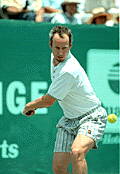 |
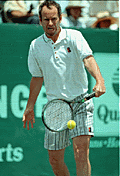 |
I personally met Tom after an intercollegiate tennis career, and he suggested that I hit the ball relatively poorly, for I seldom generated the conk. And when I tried to swing faster to improve the sound, he would admonish me that I should swing slower yet hit harder. To do so I had to meet the ball perfectly . (An aside on the conk. Once when Pancho Gonzalez was commentating on the 1960's Davis Cup match in Mexico City, he remarked that Osuna was sure to be a difficult opponent for the upcoming match because Pancho had been impressed by the sound of Osuna's hits during practice.)
Having gone out on a limb in Part One of these Stow articles by suggesting that Stow would have been critical of the Graf or Becker backhand, let me compare their backhands to the flowing and simply produced Edberg backhand. The initial backswing for Edberg is compact, the elbow remains slightly bent in the backswing, and at the end of the backswing the racquet is poised to either drive through the slice, or swoop down below the ball for a driving topspin. When the backswing is neutral (that is neither too high (Graf) or too low (Chang) then either stroke (slice or topspin) can be produced . Certainly Chang rarely produces the slice, and Graf has no confidence at all in her topspin. When the backswing is neutral, the racquet is placed behind the incoming ball, and this also enables the player to simple block the shot.
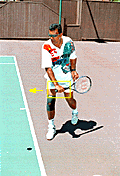 |
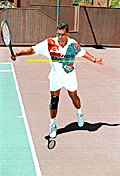 |
There is a tricky look to Graf's or Becker's backhand slice. The backswing is unusually high, the racquet swings sharply down and across the ball, and except for the skidding bounce, there is little to be said for the quality of such a hit. When the stroke is elegantly simple, like Rosewall's driving slice, Laver's driving topspin, or Edberg's slice and topspin, the hit and the results are much better .
Now to practice simple. Stand in the ready position with the hands out in front, the elbows lightly bent, and the tip of the racquet at chin height. Now the movement to prepare for the backhand calls for a 90 degree turn of hips and shoulders to the backhand, the body weight precisely shifted to the left foot, posture and balance perfect, the grip changed, and the racquet head slightly moved back. You can move the racquet back by simply turning your hand from handshake vertical to down or horizontal. Absolutely nothing else, don't straighten your elbow, don't raise the racquet above your head (Becker) don't lock your arms with the racquet down by your ankles (Chang), just take it back, and for a model think about McEnroe's backswing.
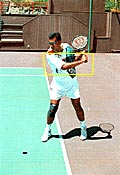 |
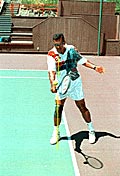 |
Since the ideal contact point is at or above the level of the net, this preparation has placed the racquet roughly in that area. And when swinging through from this position either the slice or topspin will be equally conked--providing the contact is out in front, the wrist firm, and the swinging racquet has enough momentum to win the collision. We have several good examples of this "classical" backhand in the TennisONE library, but the pictures of Nigel O'Rourke, head pro at San Francisco's Olympic Club, demonstrates it as well as any (see O'Rourke's complete backhand lesson ).
The chipped backhand which is not "conked" is not an offensive shot (Courier's slice for example). To play an all court forcing game, the ball must penetrate the opponent's court and shoot through on the bounce . The photos of O'Rourke demonstrate a Stow-like backhand slice. Note that the racquet head is higher on the slice than the drive, but there's no extreme difference. O'Rourke hits a conked, penetrating slice and you can have similar results when follow the Stow method of classical simplicity.
